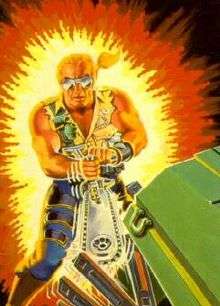
Buzzer
A buzzer or beeper is an audio signalling device, which may be mechanical, electromechanical, or piezoelectric. Typical uses of buzzers and beepers include alarm devices, timers and confirmation of user input such as a mouse click or keystroke.
History
Electromechanical
The first electric buzzer was invented in 1831 by Joseph Henry. They were mainly used in early doorbells until they were phased out in the early 1930s in favor of musical chimes, which had a softer tone.
Piezoelectric
Piezoelectric buzzers, or piezo buzzers, as they are sometimes called, were invented by Japanese manufacturers and fitted into a wide array of products during the 1970s to 1980s. This advancement mainly came about because of cooperative efforts by Japanese manufacturing companies. In 1951, they established the Barium Titanate Application Research Committee, which allowed the companies to be "competitively cooperative" and bring about several piezoelectric innovations and inventions.
Type of buzzers
Electromechanical

Buzzer (whirligig)
A buzzer (buzz, bullroarer, button-on-a-string), is an ancient mechanical device used for ceremonial purposes and as a toy. It is constructed by centring an object at the midpoint of a cord or thong and winding the cord while holding the ends stationary. The object is whirled by alternately pulling and releasing the tension on the cord. The whirling object makes a buzzing or humming sound, giving the device its common name.
A buzzer is often constructed by running string through two of the holes on a large button and is a common and easily made toy.
American Indians used the buzzer as a toy and, also ceremonially, as to call up the wind. Early Indian buzzers were constructed of wood, bone, or stone, and date from at least the Fourche Maline Culture, c. 500 B.C.
See also
References
Bibliography

Buzzer (G.I. Joe)
Buzzer is a fictional character from the G.I. Joe: A Real American Hero toyline, comic books and cartoon series of the 1980s. He is affiliated with Cobra as one of the Dreadnoks and debuted in 1985.
Profile
His real name is Dick Blinken (Richard Blinken-Smythe). Buzzer was born in Cambridge, England.
Buzzer was once an extreme left-wing Cambridge sociology don who went to Australia to research biker gangs. His experiences there transformed him into the object of his research, as years of intellectual displeasure and extreme indignation at society's two-faced morality, instilled in him a desire to take society apart with a chainsaw. Buzzer is now a scavenger of the swamps, and can cut through steel, wrought iron, and nearly any metal with his diamond-tooth chainsaw.
Toys
Buzzer was first released as an action figure in 1985.
Comics
Marvel Comics
In the Marvel Comics G.I. Joe series, he first appeared in issue #25 with Ripper and Torch. Later, the Dreadnoks are sent as an advance team to McGuire Air Force Base, as Cobra Commander believed it was the location of G.I. Joe headquarters. Buzzer's carelessness causes an explosion, which provides enough of an alert to drive off the enemy. The Dreadnoks retreat so as to not get into trouble.

Elysium
Elysium or the Elysian Fields (Ancient Greek: Ἠλύσιον πεδίον, Ēlýsion pedíon) is a conception of the afterlife that developed over time and was maintained by some Greek religious and philosophical sects and cults. Initially separate from the realm of Hades, admission was reserved for mortals related to the gods and other heroes. Later, it expanded to include those chosen by the gods, the righteous, and the heroic, where they would remain after death, to live a blessed and happy life, and indulging in whatever employment they had enjoyed in life.
The Elysian Fields were, according to Homer, located on the western edge of the Earth by the stream of Okeanos. In the time of the Greek oral poet Hesiod, Elysium would also be known as the Fortunate Isles or the Isles (or Islands) of the Blessed, located in the western ocean at the end of the earth. The Isles of the Blessed would be reduced to a single island by the Thebean poet Pindar, describing it as having shady parks, with residents indulging their athletic and musical pastimes.

List of songs composed by Franz Schubert
The following is a list of the complete secular vocal output composed by Franz Schubert (31 January 1797 – 19 November 1828).
It is divided into eleven sections, and attempts to reflect the most current information with regards to Schubert’s catalogue. The works contained in this list refer to those found primarily in the following two series of the Neue Schubert-Ausgabe (NSA) edition:
Note however that some of Schubert's song cycles contain both Lieder and part songs.
The list below includes the following information:
Scott Brown (DJ)
Scott Alexander Brown (born 28 December 1972) is a Glasgow-born Scottish DJ and music producer, now living in Huddersfield, West Yorkshire. Brown produces and plays a variety of genres commonly called rave. Although he is most associated with bouncy techno, his music ranges from happy hardcore, through hard trance, to gabber. He is the founder of Evolution Records, which started in 1994.
Hardcore techno
He was heavily involved in the evolution of the UK's hardcore techno scene from the early 1990s, in particular introducing the harder-edged sounds of Belgian and Dutch techno to the UK, and taking the Scottish sounds to Europe. He DJs at rave events in the UK, the Netherlands, the US, and locations worldwide. A more detailed background of Brown's music style is given at bouncy techno.
Music production
Brown has produced music on his own record labels (Evolution Records, Evolution Plus, Evolved, Evolution Gold, Poosh, Screwdriver and Twisted Vinyl), and under a range of monikers including Plus System,The Scotchman,Interstate, Bass-X (with his brother Stewart), and with his band Q-Tex, which was formed in 1991.
Podcasts:

